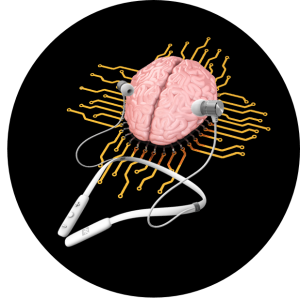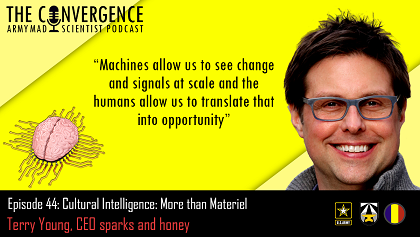[Editor’s Note: Army Mad Scientist is pleased to feature our latest episode of The Convergence podcast, with Terry Young, Founder and CEO, sparks & honey. In this episode, we discuss the future of workplaces and how to leverage artificial intelligence and machine learning to build cultural intelligence across a wide spectrum of future topics — Enjoy! (Please note that this podcast and several of the embedded links below are best accessed via a non-DoD network due to network priorities for teleworking)]
[If the podcast dashboard is not rendering correctly for you, please click here to listen to the podcast.]
 Terry Young is the Founder and CEO of sparks & honey, “a cultural intelligence consultancy helping organizations understand explosive and immediate cultural shifts, as well as cultural tastes that develop over time.” By leveraging the power of culture, sparks & honey seeks to open minds and create possibilities in the now, next, and future. Mr. Young is a frequent speaker and writer on the largest shifts that will shape the future, most recently addressing such topics as precision consumer 2030, the rise of Generation Z, new semantics, open business, and the future of giving. His deep understanding of consumer behavior and digital and technology platforms allowed him to architect the sparks & honey model and cultural intelligence platform, QTM.
Terry Young is the Founder and CEO of sparks & honey, “a cultural intelligence consultancy helping organizations understand explosive and immediate cultural shifts, as well as cultural tastes that develop over time.” By leveraging the power of culture, sparks & honey seeks to open minds and create possibilities in the now, next, and future. Mr. Young is a frequent speaker and writer on the largest shifts that will shape the future, most recently addressing such topics as precision consumer 2030, the rise of Generation Z, new semantics, open business, and the future of giving. His deep understanding of consumer behavior and digital and technology platforms allowed him to architect the sparks & honey model and cultural intelligence platform, QTM.
In our interview with Mr. Young, we discuss the future of workplaces and how to achieve and measure it, and how to leverage Artificial Intelligence (AI) and machine learning to build cultural intelligence across a wide spectrum of future topics. The following bullet points highlight key insights from our interview:
-
-
- Cultural intelligence can help us understand why humans make the decisions that they make and how we can translate that information into opportunities. At scale, it can identify weak signals and emerging threats and help organizations anticipate change.
-
-
-
- sparks & honey leverages AI and man-machine teaming to identify the impacts of cultural trends.
-
-
-
-
- QTM — their AI cultural analysis system — uses natural language processing to analyze and map cultural trends at scale by scouring myriad sources — social media, patents, blogs, influencers, policy changes, academic papers, scientific discoveries — and then building a taxonomy of culture to categorize, cluster, and quantify these different ‘signals.’
-
-
-
-
-
- The humans in this man-machine equation translate these signals into opportunities by adding nuance, intuition, and context to make sense of these trends and where the world is heading.
-
-
-
-
- Cultural trends are classified in a ‘stack’ with three levels. Megatrends, like climate change, will structurally change society in the long term, 8-10 years out. Macrotrends will create impacts in 1-3 years, while Micro-signals indicate short term changes.
-
-
-
- Cultural Intelligence identifies the drivers of cultural change – not just what is happening, but why it is happening. For the military, cultural intelligence could help identify the emergence of radical ideologies and track new and convergent trends affecting the Operational Environment.
-
-
-
- Due to changes arising from the COVID-19 global pandemic, work environments are shifting and employees are likely to prioritize fairness and moral leadership in the workplace and outside of it. Negative perceptions about uniformed service, exacerbated by our adversaries’ information operations, could reduce the pool of interested recruits.
- Due to changes arising from the COVID-19 global pandemic, work environments are shifting and employees are likely to prioritize fairness and moral leadership in the workplace and outside of it. Negative perceptions about uniformed service, exacerbated by our adversaries’ information operations, could reduce the pool of interested recruits.
-
-
-
- The pandemic has also increased the velocity at which businesses will be expected to prioritize employee wellness. Leaders need to be thinking about the physical, mental, and emotional well-being of their workforce. For the Army, prioritizing wellness – with an emphasis on mental health – will be essential in maintaining Soldier readiness.
-
-
-
- Given that change is inevitable, organizations should focus on building resilience rather than mitigation or aversion. This strategy will help prevent disruption and chaos when unforeseen changes occur, but will also better prepare them to ‘see around corners’ and anticipate changes that will impact their operations.
-

Stay tuned to the Mad Scientist Laboratory for our next episode of The Convergence, featuring our interview with Dr. Brent Sterling, Adjunct Professor at Georgetown University’s Edmund A. Walsh School of Foreign Service and author of Other People’s Wars: The US Military and the Challenge of Learning from Foreign Conflicts, discussing how militaries learn (or don’t!) from foreign conflicts, what pitfalls await those trying to learn from historical conflicts, how focusing only on “relevant” observations hampers our creativity in analyzing warfare, and what strategists can do to avoid past mistakes.
If you enjoyed this post, check out the Key Judgements excerpted from The Operational Environment (2021-2030): Great Power Competition, Crisis, and Conflict, and download the comprehensive source document;
… learn more about the U.S. Army’s single consistent OE narrative (spanning the near, mid-, and far terms out to 2050) in:
Four Models of the Post-COVID World, The Operational Environment: Now through 2028, and Threats to 2030 video
The Future Operational Environment: The Four Worlds of 2035-2050, the complete AFC Pamphlet 525-2, Future Operational Environment: Forging the Future in an Uncertain World 2035-2050, and associated video;
… and review the following additional related content:
On Hype and Hyperwar by Collin Meisel and Dr. Jonathan D. Moyer
Emergent Global Trends Impacting on the Future Operational Environment
The Inexorable Role of Demographics, by Caroline Duckworth
Own the Heat: DoD Climate Change Action with Richard G. Kidd IV, the associated podcast, and The Inevitable Threat: Climate Change and the Operational Environment
Going on the Offensive in the Fight for the Future and associated podcast



